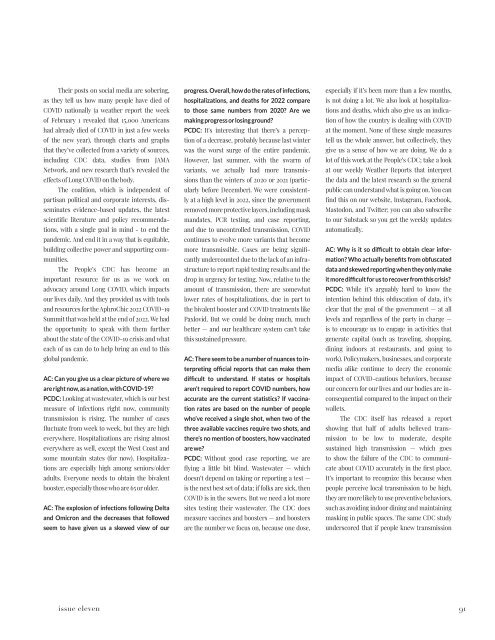AphroChic Magazine: Issue No. 11
You also want an ePaper? Increase the reach of your titles
YUMPU automatically turns print PDFs into web optimized ePapers that Google loves.
Their posts on social media are sobering,<br />
as they tell us how many people have died of<br />
COVID nationally (a weather report the week<br />
of February 1 revealed that 15,000 Americans<br />
had already died of COVID in just a few weeks<br />
of the new year), through charts and graphs<br />
that they’ve collected from a variety of sources,<br />
including CDC data, studies from JAMA<br />
Network, and new research that’s revealed the<br />
effects of Long COVID on the body.<br />
The coalition, which is independent of<br />
partisan political and corporate interests, disseminates<br />
evidence-based updates, the latest<br />
scientific literature and policy recommendations,<br />
with a single goal in mind - to end the<br />
pandemic. And end it in a way that is equitable,<br />
building collective power and supporting communities.<br />
The People’s CDC has become an<br />
important resource for us as we work on<br />
advocacy around Long COVID, which impacts<br />
our lives daily. And they provided us with tools<br />
and resources for the <strong>AphroChic</strong> 2022 COVID-19<br />
Summit that was held at the end of 2022. We had<br />
the opportunity to speak with them further<br />
about the state of the COVID-19 crisis and what<br />
each of us can do to help bring an end to this<br />
global pandemic.<br />
AC: Can you give us a clear picture of where we<br />
are right now, as a nation, with COVID-19?<br />
PCDC: Looking at wastewater, which is our best<br />
measure of infections right now, community<br />
transmission is rising. The number of cases<br />
fluctuate from week to week, but they are high<br />
everywhere. Hospitalizations are rising almost<br />
everywhere as well, except the West Coast and<br />
some mountain states (for now). Hospitalizations<br />
are especially high among seniors/older<br />
adults. Everyone needs to obtain the bivalent<br />
booster, especially those who are 65 or older.<br />
AC: The explosion of infections following Delta<br />
and Omicron and the decreases that followed<br />
seem to have given us a skewed view of our<br />
progress. Overall, how do the rates of infections,<br />
hospitalizations, and deaths for 2022 compare<br />
to those same numbers from 2020? Are we<br />
making progress or losing ground?<br />
PCDC: It's interesting that there’s a perception<br />
of a decrease, probably because last winter<br />
was the worst surge of the entire pandemic.<br />
However, last summer, with the swarm of<br />
variants, we actually had more transmissions<br />
than the winters of 2020 or 2021 (particularly<br />
before December). We were consistently<br />
at a high level in 2022, since the government<br />
removed more protective layers, including mask<br />
mandates, PCR testing, and case reporting,<br />
and due to uncontrolled transmission, COVID<br />
continues to evolve more variants that become<br />
more transmissible. Cases are being significantly<br />
undercounted due to the lack of an infrastructure<br />
to report rapid testing results and the<br />
drop in urgency for testing. <strong>No</strong>w, relative to the<br />
amount of transmission, there are somewhat<br />
lower rates of hospitalizations, due in part to<br />
the bivalent booster and COVID treatments like<br />
Paxlovid. But we could be doing much, much<br />
better — and our healthcare system can’t take<br />
this sustained pressure.<br />
AC: There seem to be a number of nuances to interpreting<br />
official reports that can make them<br />
difficult to understand. If states or hospitals<br />
aren’t required to report COVID numbers, how<br />
accurate are the current statistics? If vaccination<br />
rates are based on the number of people<br />
who’ve received a single shot, when two of the<br />
three available vaccines require two shots, and<br />
there’s no mention of boosters, how vaccinated<br />
are we?<br />
PCDC: Without good case reporting, we are<br />
flying a little bit blind. Wastewater — which<br />
doesn’t depend on taking or reporting a test —<br />
is the next best set of data; if folks are sick, then<br />
COVID is in the sewers. But we need a lot more<br />
sites testing their wastewater. The CDC does<br />
measure vaccines and boosters — and boosters<br />
are the number we focus on, because one dose,<br />
especially if it’s been more than a few months,<br />
is not doing a lot. We also look at hospitalizations<br />
and deaths, which also give us an indication<br />
of how the country is dealing with COVID<br />
at the moment. <strong>No</strong>ne of these single measures<br />
tell us the whole answer, but collectively, they<br />
give us a sense of how we are doing. We do a<br />
lot of this work at the People’s CDC; take a look<br />
at our weekly Weather Reports that interpret<br />
the data and the latest research so the general<br />
public can understand what is going on. You can<br />
find this on our website, Instagram, Facebook,<br />
Mastodon, and Twitter; you can also subscribe<br />
to our Substack so you get the weekly updates<br />
automatically.<br />
AC: Why is it so difficult to obtain clear information?<br />
Who actually benefits from obfuscated<br />
data and skewed reporting when they only make<br />
it more difficult for us to recover from this crisis?<br />
PCDC: While it’s arguably hard to know the<br />
intention behind this obfuscation of data, it’s<br />
clear that the goal of the government — at all<br />
levels and regardless of the party in charge —<br />
is to encourage us to engage in activities that<br />
generate capital (such as traveling, shopping,<br />
dining indoors at restaurants, and going to<br />
work). Policymakers, businesses, and corporate<br />
media alike continue to decry the economic<br />
impact of COVID-cautious behaviors, because<br />
our concern for our lives and our bodies are inconsequential<br />
compared to the impact on their<br />
wallets.<br />
The CDC itself has released a report<br />
showing that half of adults believed transmission<br />
to be low to moderate, despite<br />
sustained high transmission — which goes<br />
to show the failure of the CDC to communicate<br />
about COVID accurately in the first place.<br />
It’s important to recognize this because when<br />
people perceive local transmission to be high,<br />
they are more likely to use preventive behaviors,<br />
such as avoiding indoor dining and maintaining<br />
masking in public spaces. The same CDC study<br />
underscored that if people knew transmission<br />
issue eleven 91

















